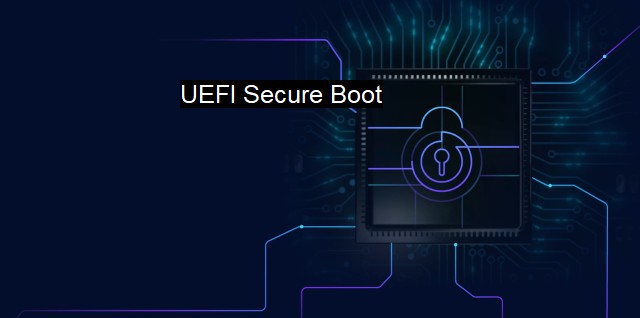What is UEFI Secure Boot?
Secure Boot: Protecting Your Computer from Malware and Cybersecurity Threats
UEFI Secure Boot is a security standard developed by members of the PC industry to address the increasing threats facing computer systems today. Based on Unified Extensible Firmware Interface (UEFI), Secure Boot prevents unauthorized operating systems and software from loading during the start-up process. UEFI Secure Boot plays an essential role in protecting computer systems against cyber threats.In order to comprehend how UEFI Secure Boot works, it is vital to understand UEFI first. UEFI replaces the traditional Basic Input/Output System (BIOS) found in most computers. It extends the capabilities of BIOS and gives it new features like Secure Boot, faster boot-up times, support for drives larger than 2 TB, among others.
UEFI Secure Boot improves the security model for the pre-operating system environment, offering high levels of protection against boot loaders and firmware-level malware threats. Using digital signatures and cryptography, it ensures that the system's firmware loads only officially signed and approved code.
Before loading any piece of software, UEFI Secure Boot checks the signature against a database of approved signatures - known as the Signature Database (DB). If it finds a match, the software is allowed to run. Otherwise, the software is stopped dead in its tracks. This makes it exceedingly difficult for hackers to tamper with a system at the boot level.
An additional feature of UEFI Secure Boot is the Forbidden Signature Database or DBX. Any software marked on this list is unquestionably denied execution permission, even if it has a digital signature. These could be previous vendors' software versions known to contain vulnerabilities now disallowed, or signatures associated with known malware threats.
UEFI Secure Boot drastically reduces the risk of malware embedding itself within the system and gaining control over a computer's operating system. This specifically includes rootkits, virus threats, or ransomware able to modify the boot-loader. Once activated, these types of malware can be tricky to detect and can sometimes survive operating system re-installations or even full hard drive wipes.
While UEFI Secure Boot is a significant step forward in system security, it is by no means a comprehensive solution to all malware threats. Besides the security offered at the boot level, further protection measures for the operating system and its applications are crucial. These include keeping your system up-to-date, relying on robust antivirus software, and maintaining secure online practices.
UEFI Secure Boot also has some limitations. If not properly managed, it can cause issues with dual booting systems, or systems that run more than one operating system. Some software or hardware may also be incompatible if they have not been properly signed and recognized by the UEFI firmware. There have also been instances where Secure Boot has been bypassed by vulnerabilities or bugs in firmware implementations.
From a cybersecurity perspective, UEFI Secure Boot, despite its limitations, is a critical defensive measure against low-level attacks that are difficult to detect with regular software antiviruses. It provides considerable protection at the earliest possible point – the boot process, making it an indispensable part of today's security landscape.
While not a standalone measure for total system security, UEFI Secure Boot helps construct a multi-layered defense strategy against increasingly sophisticated cyber-attacks. By reducing the possibility of root-level intrusions, it allows other security measures such as antivirus and antispyware software to perform their tasks more effectively.

UEFI Secure Boot FAQs
What is UEFI Secure Boot and how does it enhance cybersecurity?
UEFI Secure Boot is a security feature in modern computer systems that ensures only authorized operating systems and drivers are loaded during the boot process. It helps prevent malicious software, such as viruses and rootkits, from infecting the system, making it more difficult for attackers to compromise the system's security.Can UEFI Secure Boot prevent all types of malware attacks?
While UEFI Secure Boot can effectively prevent rootkits and bootkits, it is not a silver bullet against all types of malware. Sophisticated attackers can still find ways to bypass the secure boot process through vulnerabilities in the firmware or other layers of the system. However, UEFI Secure Boot is an important step in the right direction towards a more secure system.Do all antivirus and security software work with UEFI Secure Boot?
Most antivirus and security software are compatible with UEFI Secure Boot, but it is important to confirm compatibility before installing any software. Some older antivirus software may not work with Secure Boot enabled, as they rely on older boot process techniques that are not supported under UEFI Secure Boot.What should I do if I am unable to boot my system after enabling UEFI Secure Boot?
If enabling UEFI Secure Boot results in booting issues, try disabling Secure Boot and check if the issue is resolved. In some cases, the boot failure may be due to an incompatible driver or firmware, and updating them may fix the issue. It is also important to ensure that the operating system and drivers are properly signed to work with Secure Boot. If the issue persists, contact the system manufacturer or a qualified technician for assistance.| | A | | | B | | | C | | | D | | | E | | | F | | | G | | | H | | | I | | | J | | | K | | | L | | | M | |
| | N | | | O | | | P | | | Q | | | R | | | S | | | T | | | U | | | V | | | W | | | X | | | Y | | | Z | |
| | 1 | | | 2 | | | 3 | | | 4 | | | 7 | | | 8 | | |||||||